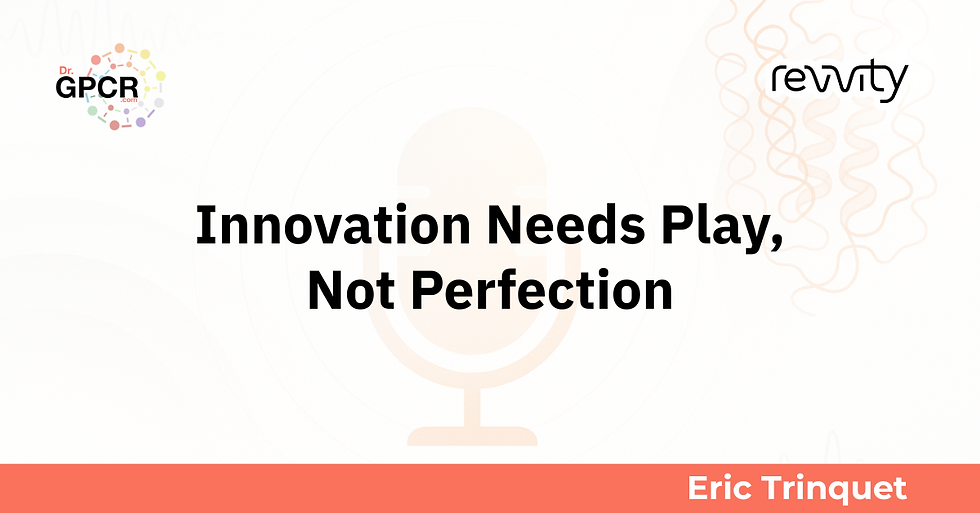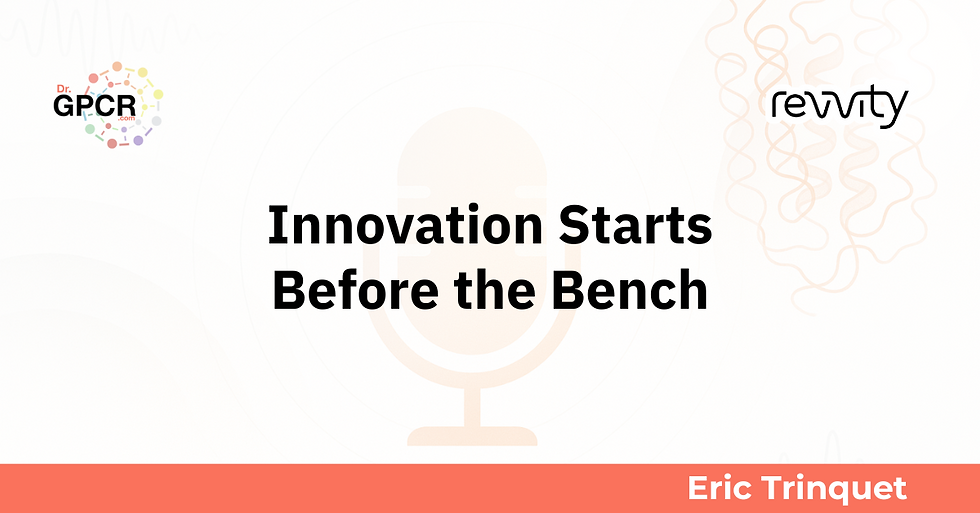Innovative Data-Driven Solutions: The pHSense Revolution
- Dr. GPCR Podcast

- Sep 26
- 3 min read
Updated: Oct 22

You never forget the day your data surprises you—in a positive way.
For Dr. Eric Trinquet, that moment arrived when his team successfully tracked GPCR internalization in native beta cells. They achieved this without complex imaging or radioactive materials.
It was simply a clean, scalable assay—and a wave of new possibilities. This success was not mere luck. It was the result of chemistry, collaboration, and relentless effort until the signal finally confirmed: “We’re in.”
From Bench to Breakthrough: Why pHSense Matters
Decades of GPCR research have relied heavily on engineered systems. These include overexpression, tags, and fluorescent imaging. While they produce impressive data, they also impose artificial constraints.
What if you could directly measure receptor internalization in physiologically relevant cells without disrupting their native state?
That’s the promise of pHSense, a groundbreaking reagent developed by Eric Trinquet and his team at Revvity. This innovation emerged from years of foundational work in photophysics and GPCR pharmacology.
Instead of creating another black-box assay, they designed pHSense around rare-earth europium probes. These probes shift brightness and fluorescence lifetime as pH changes.
It’s a subtle yet powerful innovation.
These probes become brighter and have a longer lifespan as internalized receptors enter acidic endosomes—translating biology into signal, instantly and accurately.
Why does this matter?
Until now, visualizing GPCR trafficking required imaging or forced overexpression. pHSense offers a high-throughput, no-wash, plate-reader-compatible assay with real-world relevance.
The Chemistry That Almost Didn’t Work
Designing pH-sensitive rare-earth complexes was not an obvious choice. The chemistry involved is notoriously complex. Solubility poses significant challenges. Even minor adjustments can compromise photophysical properties.
However, Trinquet’s team, in collaboration with Professor David Parker from Durham University, cracked the code. They learned how to fine-tune both brightness and fluorescence lifetime. This led to the creation of a two-dimensional pH response curve capable of detecting subtle endosomal acidification.
“You’re not changing the spectrum. You’re just changing how bright it is—and how long it glows,” said Dr. Eric Trinquet.
Once they identified a lead compound, it became evident: this was not just another probe. This was the foundation of a new set of assay tools.
The Day It Worked — Without Overexpression
Trinquet describes this as a cornerstone moment.
After months of adjustments, a scientist on his team presented a data set that transformed everything: a clean, dose-dependent response of GLP-1 receptor internalization in native beta cells.
No imaging. No genetic modification. Just a plate reader, an agonist, and an endogenous GPCR.
This achievement was not only technically impressive; it was conceptually transformative. For the first time, a team demonstrated high-throughput internalization data in physiologically relevant cells.
Behind Every Probe Is a Partnership
While the final product may arrive neatly packaged, the journey behind pHSense was anything but straightforward.
The chemistry originated from Parker’s lab.
The biological validation came from Jean-Philippe Pin’s group at the Genomic Functional Institute in Montpellier.
The Revvity team acted as the glue.
They constructed the platform, tested every variable—pKa, brightness, lifetime—and made decisions that few would even consider measuring.
These were not mere vendor-supplier relationships. They were collaborative scientific ventures, years in the making. The outcome is not just a probe; it’s a tool scientists can trust.
Mini Timeline: pHSense Development
Early 2020s: Rare-earth probe synthesis begins
Collaborative screening of scaffold families
Key milestone: Clean signal in endogenous beta cells
Revvity commercial launch
Building a Scalable Platform — Not a One-Off Assay
The brilliance of pHSense lies not only in the chemistry but also in its modularity. The assay is compatible with SNAP-tags, FLAG-tags, HA-tags, and even antibody fragments for native GPCRs.
Whether in industry or academia, whether overexpressing or not, you can adapt the assay to your system. Since it operates on plate readers without wash steps, it is suitable for full-scale compound screening.
“Don’t chase the shiny imaging tool if it doesn’t scale. Build or adopt assays that can evolve with your questions—like pHSense.”
What’s Next? Follow the Feedback
For Trinquet, commercialization is not the end; it’s a new beginning.
User feedback will guide the development of future tags and variants. Teams are already investigating temperature effects, biased signaling, and endogenous dynamics.
There is excitement about combining pHSense with other HTRF assays for multi-pathway mapping—G protein, arrestin, internalization—on the same cell line. What started as a chemistry problem has evolved into a discovery platform.
“It’s like a funnel,” Trinquet explains. “You start wide with chemistry, you narrow with biology, and at the end—if you did it right—you open new doors.”
To hear the full story of how pHSense came to life—and why the GLP-1 data changed everything—
⸻
More about Revvity
⸻
Want more like this?
👉 Join the Dr. GPCR Premium Ecosystem for behind-the-scenes access to GPCR innovators, exclusive deep-dives, and practical tools to accelerate your research or career.
👥 Build connections. 🧪 Get insights. 🎧 Stay ahead.




Comments